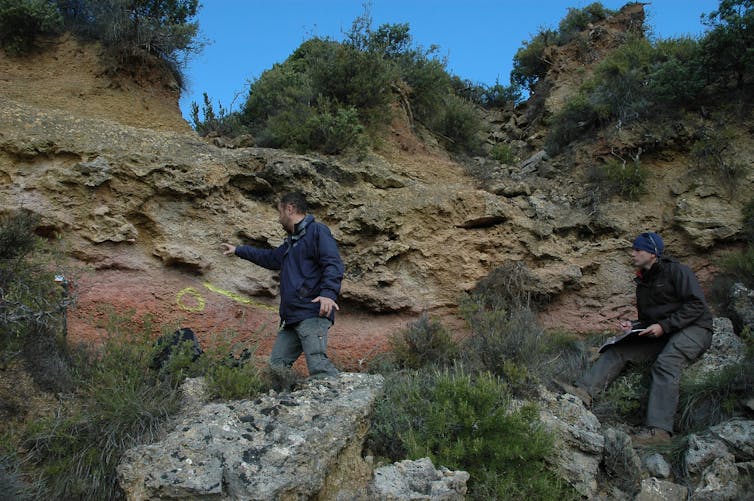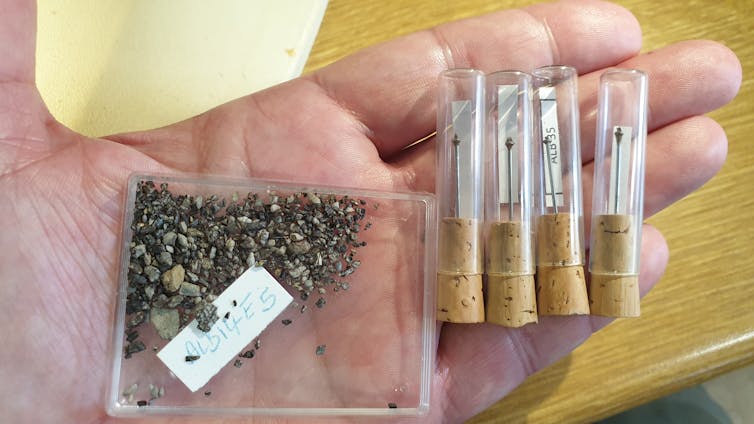Global warming 56 million years ago: can past biodiversity help us anticipate the future?
In the face of today's major climatic upheavals, a key question arises: how will animals, and mammals in particular, respond to future temperature rises?
Rodolphe Tabuce, University of Montpellier

To provide food for thought based on observed facts, we can turn to the past, some 56 million years ago. At that time, two short but very intense climatic warm-ups coincided with unprecedented faunal changes in Europe. We have just published our work in the journal PNAS, which provides a better understanding of this pivotal stage in the history of mammals.
Warming conditions favour mammals
The first heat peak whose consequences we have studied and summarized is known as the Paleocene-Eocene Thermal Maximum (or PETM). This hyperthermal event, dated at 56 million years ago, saw continental temperatures rise by 5-8°C in less than 20,000 years. Of course, this timeframe is out of all proportion to the rapid rise in temperatures over the past two centuries due to human activity, but paleoclimatologists consider the PETM to be the best geological analogue to current warming in terms of its rapidity on the geological timescale, its amplitude and its cause: a massive release of methane andCO2 into the atmosphere, most likely resulting from gigantic basalt outpourings over the entire present-day North Atlantic (Greenland, Iceland, Norway, northern UK and Denmark).
These powerful greenhouse gases, and the resulting rise in temperature, have caused upheavals in the fauna and flora of all marine and terrestrial ecosystems. In Europe, Asia and North America, the PETM coincided with the sudden appearance of the first primates (represented today by monkeys, lemurs and tarsiers), artiodactyls (represented today by ruminants, camels, pigs, hippopotamuses and cetaceans) and perissodactyls (represented today by horses, zebras, tapirs and rhinoceroses). This event therefore played a major role in the development of the biodiversity we know today.
But just before this great upheaval, another, shorter and less intense hyperthermal episode, known as the PETM Pre-Onset Event (or POE), occurred around 100,000 years earlier, at around 56.1 million years ago. Today, it is estimated that the POE caused temperatures to rise by 2°C. Some scientists believe that this initial "heatwave" may have triggered the PETM through a cascade effect. Returning to the evolution of paleo-biodiversities, while the impact of the PETM on mammalian faunas is relatively well understood, the impact of the POE remained unknown prior to our work.
Meticulous fieldwork in Occitania
To answer this question, we focused our research in southern France, in the Massif des Corbières (Aude department, Occitanie region), where the geological layers of the transition between the Paleocene and Eocene are numerous and very thick, giving us hope of identifying PETM, POE and mammal paleontological deposits dated before and after the two heat peaks. In other words, our aim was to describe very clearly and objectively the direct effects of these warming events on mammal faunas.
For several years, we have been conducting multidisciplinary studies, combining the expertise of paleontologists, geochemists, climatologists and sedimentologists. In addition, through participatory science initiatives, we have involved amateur paleontologists, naturalists and other enthusiasts of the Corbières Massif in our field research (paleontological surveys and excavations). Our work led to the discovery of a mammal fauna in the commune of Albas. This fauna is perfectly dated to the very short time interval between the POE and the PETM. To date a paleontological site over 56 million years old to within a few thousand years is nothing short of remarkable. The resulting scenarios, particularly those relating to the history of mammals (date of appearance of species and their geographical dispersal), are therefore very precise.

The fossiliferous deposit discovered at Albas was dated by isotope analysis of the organic carbon contained in the geological layers. The sedimentary rocks (limestones, marls and sandstones) found in nature today are the result of the accumulation of sediments (sands, silts, gravels, clays) deposited in superimposed layers, known as strata. In Albas, the sediments encountered are mainly marl, interspersed with small banks of limestone and sandstone. Think of this "geological mille-feuille" as the pages of a book: they tell us a story set in time. This time can be calculated in different ways. While archaeologists use carbon 14, geologists, paleoclimatologists and paleontologists prefer to use, for example, the ratio of stable carbon isotopes(13C/12C). This method has a dual benefit: it provides information on the presence of hyperthermal events during the original deposition of sediments (the more negative the ratio between 13C/12Cisotopes, the warmer the inferred temperatures), and it enables us to give a precise age to strata, since hyperthermal events are brief, well-dated episodes. The sudden increase in 12Cin the atmosphere during hyperthermal events is explained by the rapid release of ancient reservoirs of organic carbon, naturally enriched in 12C, notably as a result of past plant photosynthesis. Today, as in the past, plants prefer to use 12C: lighter than 13C, it can be mobilized more quickly by the organism.
Thus, POE and PETM are identified by very strongly negative values of the 13C/12Cratio. The power of this method is such that it can be applied both to sediments of oceanic origin and to sediments of continental origin deposited in lakes and rivers, as at Albas. This makes it possible to compare the ages of fossiliferous deposits very accurately on a global scale. The fauna discovered at Albas can thus be compared with contemporary faunas, notably from North America and Asia, in an extremely precise chronological context.
Surprising wildlife in Albas
The Albas fauna is rich in 15 mammal species documented by over 160 fossils, mainly tooth and mandible remains. It documents rodents (the richest order of present-day mammals, with over 2,000 species, including mice, rats, squirrels, guinea pigs and hamsters), marsupials (represented today by kangaroos, koalas and sarigas), as well as primates, insectivores and carnivores that are described as "archaic". This adjective refers to the fact that the fossil species identified are not directly related to present-day species of primates, insectivores (such as hedgehogs, shrews and moles) and carnivores (felines, bears, dogs, otters, etc.). In the fossil record, numerous groups of "archaic" mammals have been documented; many appeared at the same time as the last Cretaceous dinosaurs, and most became extinct during the Eocene, certainly in the face of ecological competition with "modern" mammals, i.e. mammals directly related to present-day species. Many of these "modern" mammals appeared during the PETM and rapidly dispersed to Asia, Europe and North America via high-latitude "natural land bridges" (present-day North Greenland, Scandinavia and the Bering Strait in Siberia). These transcontinental passageways were made possible by the fact that the landscapes of today's Arctic were covered with dense tropical to para-tropical forests, providing "food and shelter" for the mammals.

In the wake of these initial geographic dispersals, we see a diversification in the number of species among all "modern" mammals, which rapidly occupy all available living environments. So, in addition to the groups already mentioned (such as the arboreal primates), it was at this time that the first chiropterans (or bats) adapted to flight and the first cetaceans adapted to aquatic life appeared. For this reason, the post-PETM period is often referred to as the key period in the history of mammals, as it corresponds to the innovative phase of their "adaptive radiation", i.e. their rapid evolution, characterized by great ecological and morphological diversity.
A discovery that changes scenarios
But let's go back to before the PETM, more than 100,000 years earlier, just before the POE, during the very end of the Paleocene. At that time, European faunas were thought to be composed of "archaic" species, essentially endemic to Europe. At the time, the continent was fairly isolated from other neighbouring landmasses by shallow seas.
The Albas fauna challenges this scenario. Archaic" species, essentially endemic, cohabit with - and this is the surprise - cosmopolitan "modern" species! These include rodents and marsupials, of which Albas documents the oldest European species, the first known with certainty in the Paleocene. A detailed study of Albas' fauna reveals that the direct ancestors of most of the species discovered testify to a North American origin, and in particular within species known from the American state of Wyoming dated to before the POE. The conclusion is simple: these mammals did not migrate from North America during the PETM as previously thought, but somewhat earlier, most likely during the POE. In contrast to the "archaic" Paleocene and "modern" Eocene mammals, we have therefore described the Albas mammals as "precursors". These "precursor" mammals, like their "modern" cousins 100,000 years later in the PETM, reached Europe via the warm, humid forests of present-day Greenland and Scandinavia. What a surprise to think of American marsupials arriving in Europe via the Arctic!
Our next studies will document European faunas just before the POE, to better understand the impact of this hyperthermal event, less well known than the PETM, but just as decisive for mammal history. Returning to our original hypothesis - the idea of an analogy between past and future biodiversity - our research shows that the PETM led to a major migration of American mammals to Europe, thanks to a rise in temperature of around 2°C. This could provide us with some food for thought. This could provide us with food for thought about the future of European biodiversity in the current context of similar warming.
The EDENs project is supported by the French National Research Agency (ANR), which funds project-based research in France. Its mission is to support and promote the development of fundamental and applied research in all disciplines, and to strengthen the dialogue between science and society. To find out more, visit theANR website.
Rodolphe Tabuce, CNRS Research Fellow, University of Montpellier
This article is republished from The Conversation under a Creative Commons license. Read theoriginal article.